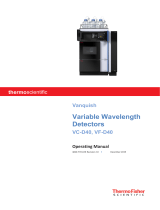
ETC Quick Guide
Desire Fixture Series
D22, D40, D40XT, D60, D60X Fixtures Page 5 of 12 Electronic Theatre Controls, Inc.
Quick Setups
D40XT, D40, D60, and D60X – Vivid, Lustr+, Fire, Ice, Studio HD
D22 – Lustr+, Studio HD
D22, D40, D40XT, D60, and D60X – Studio Tungsten and
Studio Daylight
Quick
Setup
Profile Features Recommended For:
Studio Studio
Linear dimming curve, regulated
output mode for color consistency
Studio factory default: enables three-
parameter control of white light
(intensity, white point, and tint) via DMX
from a console or console-free fixture
display
General Direct
Standard dimming curve, regulated
output for color consistency.
3200K white point setting
Factory default: for general purpose use,
including interior architectural
applications
Stage
HSI
Plus 7 enabled
Incandescent dimming curve,
regulated output for color
consistency, 3200K white point
setting
Theatrical lighting: duplicates the color
and dimming behavior of tungsten and
stage lighting fixtures
High
Impact
RGB
Quick dimming curve, boost mode
for maximum intensity, 5600K
white point setting
Event lighting: enables quick response,
simple RGB control and strobe channel
for maximum effect usage
Quick
Setup
Profile Features Recommended For:
Studio Studio
Linear dimming curve, regulated
output for intensity stability
Enables control of intensity from
luminaire’s user interface; no console
required
Single
Channel
Direct
Standard dimming curve, regulated
output for color consistency
For general purpose architectural use
Stage Direct
Incandescent dimming curve,
regulated output
Matches conventional luminaire
performance

















